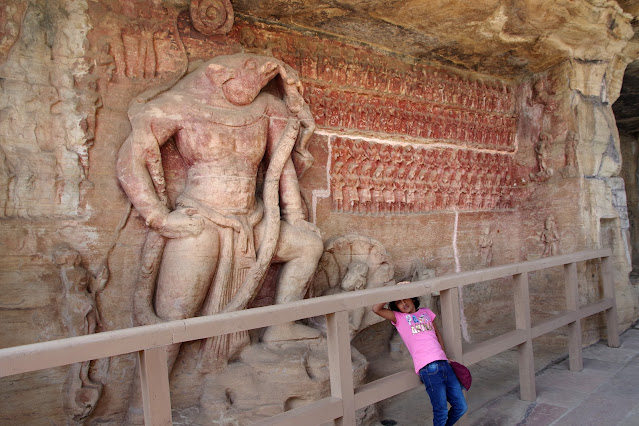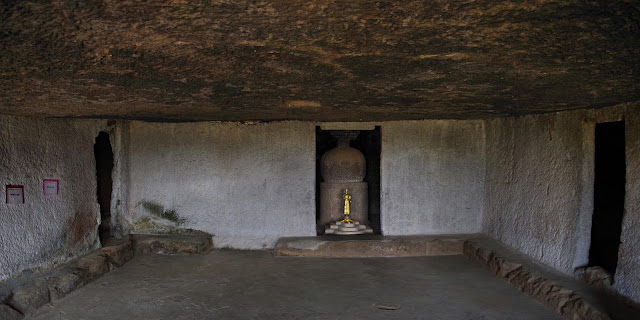Udayagiri caves
 |
| Vamanan at cave #5 |
Udayagiri Caves (Udayagiri literally translates to Sunrise Mountain) are a collection of 20 rock-cut caves in Madhya Pradesh, India. They belong from 3 -5 century AD from the Gupta era. The caves are predominantly Hindu caves but a few are Jain.
There is a museum adjacent to the caves and make sure to visit it. The museum has the following to saw about the magnificent Vamananan statue at cave #5.
+++Quote++
There is a mythological story behind the scene that when the demon Hiranyaksha captured the earth (goddess Bhudevi) and hid her in the deep waters. Then Lord Vishnu appeared as Varaha to save her from this demon. Then Varaha killed this demon and rescued the earth from cosmic world by lifting her on his right tusks and restored Bhudevi to her place in the universe.
 |
| Cave no:5 |
The most outstanding contribution of Gupta period to the Indian sculptural art at Udayagiri is the carving of a huge image of Varaha incarnation. The image is impressive in its size, shows powerful execution and aggressiveness. Here Varaha image represented as a man with boar’s head. Ichnographically, face shows the aggressiveness. The left hand kept over the hip and the right hand resting on the knee. The left foot stamps upon the coil of Naga King who has a canopy of 13 snakes (7 in front and 6 in intervals). Mother earth is raised with his right tusk from the deep water shown in form of a series of wavy lines. Behind the Naga king, the kneeling image may be a portrait of Chandragupta-2.
Towards the right side 4 and left side 5 rows are containing Brahma, Shiva on Nandi, other Gods shown with haloes, heavenly musicians, Asuras or demons, Rishis, humans etc on the right and left side niche. Sculptor has portrayed the decent of Ganga and Yamuna from heaven to sea. Here, heaven is represented by flying Devas and Apsaras are playing and dancing below them. The sea God Varuna is also carved on the lower portion and holding a water vessel in his hands.
The Varaha incarnation might be known as a political metaphor. According to scholars, Chandragupta’s conquests were an extraordinary achievement, which only the emperor was able to accomplish because he represented the glory of Maha Vishnu, the primeval boar. The idea caught the imagination of the people.
++Unquote+++
 |
| Karthekeyan at cave #3 |
Most of the caves at Udayagiri are Vaishnava caves. Vaishnavites are worshippers of Hindu God Vishnu. The Gupta rulers were patrons of Shaivism (worshippers of Lord Shiva) and also Jainism. I'm typing down the text given at the museum.
++++Quote++++
 |
| Cave number 6 |
Udayagiri caves have a unique distinction of being the only site, which can be personally associated with the Gupta Monarch Chandragupta-2 who endorsed the title of Paramabhagvat. The Vaishnava images of these include colossal statues of Varaha Incarnation (cave no: 5) and Seshsayi Vishnu (Cave no: 13). The other important images are standing Vishnu on the façade of cave No: 6, Narasimha Avatara at cave no: 12 and cave no: 19 contains the Amritamanthana scene with the panel of Navagrahas.
 |
| Carvings on cave number 6 |
Gupta rulers were the followers of Vaishnava religion but at the same time, they have equally contributed in the establishment of Shaiva, Jaina and Buddhist sects. In this area, cane no: 4,6 & 19 are dedicated to Shaiv sect of Hinduism. Cave no: 1 & 20 are Jain caves and the inscription found at cave no: 20 gave information that this cave was hewn out during the reign of Kumaragupta. At Sanchi, inscription of Chandragupta-2 is an epigraphic record documenting a donation to the Buddhist establishment at Sanchi by Gupta rulers.
++Unquote+++
 |
| Cave number 2. Due to its unique shape, its called Tava Cave |
There a a few statues of Lord Ganesh. at Udayagiri But one statue is particularly fascinating. Let me copy what has been written about it at the site. +++++ Quote++++ Ganesh known as Ganapati, Vinayaka or Vignaharta is one of the most worshipped Gods in the Hindu Pantheon. This seated image of Ganesh from Udayagiri is considered as one of the oldest representations of Lord Ganesh. +++++ Unquote++++
 |
| The statue is one of the oldest representation of Ganesha |
 |
| Close up of Ganapathy statue in the last photo |
 |
| From the Udayagiri museum |
 |
| The caves are situated in the remote countryside. |
 |
| Another Ganesha statue |











Comments
Post a Comment